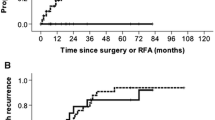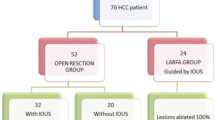Abstract
The aim of the present study was to identify predictors of outcome and complications in patients with small hepatocellular carcinoma (HCC) treated by percutaneous microwave ablation (MWA). Patients with non-previously treated small (≤ 3 cm) HCCs who underwent ultrasound (US)-guided percutaneous MWA between July 2016 and January 2019 were included. For each patient, the following variables were registered: age, sex, albumin, platelet count, INR/PT, PTT ratio, total bilirubin, liver status, etiology of liver disease, Child–Pugh classification, tumor dimension, margin, and hepatic segment, tumor subcapsular, perihilar or perivascular location, HCC focality, ascites. During follow-up, complications and outcomes were registered. Variables were then analyzed in relation to both outcomes and complications. 74 patients were included. Mean CT follow-up was 6.2 months (range 1–24 months). At least one complication occurred in 48% of patients, the majority being asymptomatic imaging findings not requiring intervention. One major complication was registered (duodenal perforation: 1.3%). The occurrence of complications was associated with HCC multifocality and abnormal INR/PT, duodenal wall edema with tumor dimension, portal vein thrombosis with Child Pugh score, perihepatic free fluid with abnormal platelet count and comorbidities. Incomplete response rate at 1 month was 18.9%. Local tumor progression and new HCC nodules rates were 13.5% and 27%, respectively. Incomplete response at 1 month was associated with both alcoholic etiology of liver disease and II segment tumor location, new HCC nodules with PBC. Despite the small series analyzed, significant factors related with complications and outcomes may be kept in mind when planning the best treatment for each patient.




Similar content being viewed by others
Data availability
All data and materials as well as software application support the published claims and comply with field standards.
References
Torre LA, Siegel RL, Ward EM, Jemal A. Global cancer incidence and mortality rates and trends—an update. Cancer Epidemiol Biomarkers Prev. 2016;25:16–27. https://doi.org/10.1158/1055-9965.EPI-15-0578.
Bruix J, Sherman M. Management of hepatocellular carcinoma: an update. Hepatology. 2011. https://doi.org/10.1002/hep.24199.
Jansen MC, van Hillegersberg R, Chamuleau RAFM, van Delden OM, Gouma DJ, van Gulik TM. Outcome of regional and local ablative therapies for hepatocellular carcinoma: a collective review. Eur J Surg Oncol. 2005. https://doi.org/10.1016/j.ejso.2004.10.011.
Tateishi R, Shiina S, Akahane M, Sato J, Kondo Y, Masuzaki R, et al. Frequency, risk factors and survival associated with an intrasubsegmental recurrence after radiofrequency ablation for hepatocellular carcinoma. PLoS ONE. 2013. https://doi.org/10.1371/journal.pone.0059040.
Livraghi T, Goldberg SN, Lazzaroni S, Meloni F, Solbiati L, Gazelle GS. Small hepatocellular carcinoma: treatment with radio-frequency ablation versus ethanol injection. Radiology. 1999. https://doi.org/10.1148/radiology.210.3.r99fe40655.
Livraghi T, Meloni F, Di Stasi M, Rolle E, Solbiati L, Tinelli C, et al. Sustained complete response and complications rates after radiofrequency ablation of very early hepatocellular carcinoma in cirrhosis: is resection still the treatment of choice? Hepatology. 2008. https://doi.org/10.1002/hep.21933.
Chen MS, Li JQ, Zheng Y, Guo RP, Liang HH, Zhang YQ, et al. A prospective randomized trial comparing percutaneous local ablative therapy and partial hepatectomy for small hepatocellular carcinoma. Ann Surg. 2006. https://doi.org/10.1097/01.sla.0000201480.65519.b8.
Forner A, Reig M, Bruix J. Hepatocellular carcinoma. Lancet. 2018. https://doi.org/10.1016/S0140-6736(18)30010-2.
Ahmed M, Brace CL, Lee FT, Goldberg SN. Principles of and advances in percutaneous ablation. Radiology. 2011. https://doi.org/10.1148/radiol.10081634.
Carrafiello G, Laganà D, Mangini M, Fontana F, Dionigi G, Boni L, et al. Microwave tumors ablation: principles, clinical applications and review of preliminary experiences. Int J Surg. 2008. https://doi.org/10.1016/j.ijsu.2008.12.028.
Simon CJ, Dupuy DE, Mayo-Smith WW. Microwave ablation: principles and applications. Radiographics. 2005. https://doi.org/10.1148/rg.25si055501.
Bhardwaj N, Dormer J, Ahmad F, Strickland AD, Gravante G, West K, et al. Microwave ablation of the liver: a description of lesion evolution over time and an investigation of the heat sink effect. Pathology. 2011. https://doi.org/10.1097/PAT.0b013e32834c356c.
Dou JP, Yu J, Yang XH, Cheng ZG, Han ZY, Liu FY, et al. Outcomes of microwave ablation for hepatocellular carcinoma adjacent to large vessels: a propensity score analysis. Oncotarget. 2017. https://doi.org/10.18632/oncotarget.15672.
Correa-Gallego C, Fong Y, Gonen M, D’Angelica MI, Allen PJ, DeMatteo RP, et al. A retrospective comparison of microwave ablation vs. radiofrequency ablation for colorectal cancer hepatic metastases. Ann Surg Oncol. 2014. https://doi.org/10.1245/s10434-014-3817-0.
van Tilborg AAJM, Scheffer HJ, de Jong MC, Vroomen LGPH, Nielsen K, van Kuijk C, et al. MWA versus RFA for perivascular and peribiliary CRLM: a retrospective patient- and lesion-based analysis of two historical cohorts. Cardiovasc Intervent Radiol. 2016. https://doi.org/10.1007/s00270-016-1413-3.
Urbonas T, Anderson EM, Gordon-Weeks AN, Kabir SI, Soonawalla Z, Silva MA, et al. Factors predicting ablation site recurrence following percutaneous microwave ablation of colorectal hepatic metastases. HPB. 2019. https://doi.org/10.1016/j.hpb.2019.01.007.
Lee HY, Rhim H, Lee MW, Kim YS, Choi D, Park MJ, et al. Early diffuse recurrence of hepatocellular carcinoma after percutaneous radiofrequency ablation: analysis of risk factors. Eur Radiol. 2013. https://doi.org/10.1007/s00330-012-2561-8.
Ahmed M, Solbiati L, Brace CL, Breen DJ, Callstrom MR, Charboneau JW, et al. Image-guided tumorablation: standardization ofterminology and reporting criteria—a 10-year update. J Vasc Interv Radiol. 2014. https://doi.org/10.1016/j.jvir.2014.08.027.
Kono M, Inoue T, Kudo M, Chishina H, Arizumi T, Takita M, et al. Radiofrequency ablation for hepatocellular carcinoma measuring 2 cm or smaller: results and risk factors for local recurrence. Dig Dis. 2014. https://doi.org/10.1159/000367999.
Kikuchi L, Menezes M, Chagas AL, Tani CM, Alencar RSSM, Diniz MA, et al. Percutaneous radiofrequency ablation for early hepatocellular carcinoma: risk factors for survival. World J Gastroenterol. 2014. https://doi.org/10.3748/wjg.v20.i6.1585.
Kang TW, Lim HK, Lee MW, Kim YS, Rhim H, Lee WJ, et al. Aggressive intrasegmental recurrence of hepatocellular carcinoma after radiofrequency ablation: risk factors and clinical significance. Radiology. 2015. https://doi.org/10.1148/radiol.15141215.
Xu Y, Shen Q, Liu P, Xu Z, Wu P, Lu Z, et al. Microwave ablation for the treatment of hepatocellular carcinoma that met up-to-seven criteria: feasibility, local efficacy and long-term outcomes. Eur Radiol. 2017. https://doi.org/10.1007/s00330-017-4740-0.
Filippiadis DK, Binkert C, Pellerin O, Hoffmann RT, Krajina A, Pereira PL. Cirse quality assurance document and standards for classification of complications: the cirse classification system. Cardiovasc Intervent Radiol. 2017. https://doi.org/10.1007/s00270-017-1703-4.
Kim YS, Rhim H, Cho OK, Koh BH, Kim Y. Intrahepatic recurrence after percutaneous radiofrequency ablation of hepatocellular carcinoma: analysis of the pattern and risk factors. Eur J Radiol. 2006. https://doi.org/10.1016/j.ejrad.2006.03.007.
Mulier S, Ni Y, Jamart J, Ruers T, Marchal G, Michel L. Local recurrence after hepatic radiofrequency coagulation: multivariate meta-analysis and review of contributing factors. Ann Surg. 2005. https://doi.org/10.1097/01.sla.0000171032.99149.fe.
Ganne-Carrié N, Nahon P. Hepatocellular carcinoma in the setting of alcohol-related liver disease. J Hepatol. 2019. https://doi.org/10.1016/j.jhep.2018.10.008.
Jones DEJ, Metcalf JV, Collier JD, Bassendine MF, James OFW. Hepatocellular carcinoma in primary biliary cirrhosis and its impact on outcomes. Hepatology. 1997. https://doi.org/10.1002/hep.510260508.
Teratani T, Yoshida H, Shiina S, Obi S, Sato S, Tateishi R, et al. Radiofrequency ablation for hepatocellular carcinoma in so-called high-risk locations. Hepatology. 2006. https://doi.org/10.1002/hep.21164.
Kang TW, Lim HK, Lee MW, Kim YS, Rhim H, Lee WJ, et al. Long-term therapeutic outcomes of radiofrequency ablation for subcapsular versus nonsubcapsular hepatocellular carcinoma: a propensity score matched study. Radiology. 2016. https://doi.org/10.1148/radiol.2016151243.
Ierardi AM, Giorlando F, Piacentino F, Fontana F, Novario R, Angileri SA, et al. Factors predicting outcomes of microwave ablation of small hepatocellular carcinoma. Radiol Medica. 2017. https://doi.org/10.1007/s11547-016-0694-6.
Yu J, Liang P, Yu XL, Cheng ZG, Han ZY, Mu MJ, et al. Local tumour progression after ultrasound-guided microwave ablation of liver malignancies: risk factors analysis of 2529 tumours. Eur Radiol. 2015. https://doi.org/10.1007/s00330-014-3483-4.
Zhang NN, Lu W, Cheng XJ, Liu JY, Zhou YH, Li F. High-powered microwave ablation of larger hepatocellular carcinoma: evaluation of recurrence rate and factors related to recurrence. Clin Radiol. 2015. https://doi.org/10.1016/j.crad.2015.06.092.
Kang TW, Lim HK, Lee MW, Kim YS, Choi D, Rhim H. Perivascular versus nonperivascular small HCC treated with percutaneous RF ablation: retrospective comparison of long-term therapeutic outcomes. Radiology. 2014. https://doi.org/10.1148/radiol.13130753.
Facciorusso A, Di Maso M, Muscatiello N. Microwave ablation versus radiofrequency ablation for the treatment of hepatocellular carcinoma: a systematic review and meta-analysis. Int J Hyperth. 2016. https://doi.org/10.3109/02656736.2015.1127434.
Ambrosino P, Tarantino L, Di Minno G, Paternoster M, Graziano V, Petitto M, et al. The risk of venous thromboembolism in patients with cirrhosis: a systematic review and meta-analysis. Thromb Haemost. 2017. https://doi.org/10.1160/TH16-06-0450.
Amitrano L, Guardascione MA, Brancaccio V, Margaglione M, Manguso F, Iannaccone L, et al. Risk factors and clinical presentation of portal vein thrombosis in patients with liver cirrhosis. J Hepatol. 2004. https://doi.org/10.1016/j.jhep.2004.01.001.
Funding
This study was not supported by any funding.
Author information
Authors and Affiliations
Contributions
All authors contributed to the study conception and design. Material preparation, data collection and analysis were performed by all authors. The manuscript was written by all authors, who also commented on previous versions of the manuscript. All authors read and approved the final manuscript.
Corresponding author
Ethics declarations
Conflict of interest
The authors declare that they have no conflicts of interest.
Additional information
Publisher's Note
Springer Nature remains neutral with regard to jurisdictional claims in published maps and institutional affiliations.
Rights and permissions
About this article
Cite this article
Biondetti, P., Fumarola, E.M., Ierardi, A.M. et al. Percutaneous US-guided MWA of small liver HCC: predictors of outcome and risk factors for complications from a single center experience. Med Oncol 37, 39 (2020). https://doi.org/10.1007/s12032-020-01365-x
Received:
Accepted:
Published:
DOI: https://doi.org/10.1007/s12032-020-01365-x




